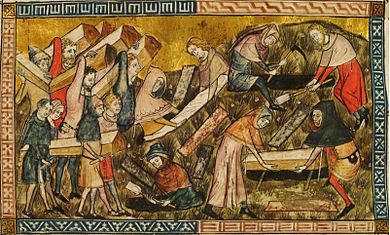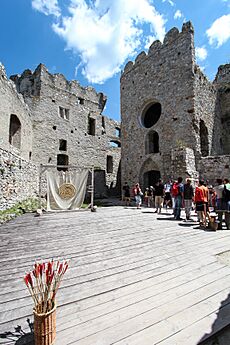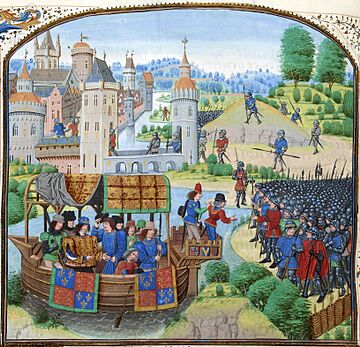Crisis of the late Middle Ages facts for kids

The crisis of the Middle Ages was a really tough time in Europe during the 14th and 15th centuries. It was like a series of big problems that changed everything. For hundreds of years before this, Europe had been quite stable. But then, three major issues hit hard:
- A huge drop in the number of people (many died).
- Governments and countries becoming unstable.
- Big disagreements and changes in religion.
These problems, like the Great Famine of 1315–1317 and the terrible Black Death plague (1347–1351), might have caused half or even more of Europe's population to die. This happened as the Medieval Warm Period ended and the Little Ice Age began. It took until the year 1500 for Europe's population to get back to what it was in 1300.
During this time, there were many uprisings by ordinary people. There were also civil wars between powerful families, like the Wars of the Roses in England. Countries fought each other too, such as France and England in the Hundred Years' War.
Even the powerful Catholic Church faced huge problems. Its unity was broken by the Western Schism, where different leaders claimed to be the true Pope. The Holy Roman Empire also became weaker. After a period called the Great Interregnum (1247–1273), the different German states became more important than the overall empire.
Contents
What Caused the Crisis?
Many historians use the term "crisis of the late Middle Ages" to describe these difficult times. They often talk about different types of crises, like the urban (city) crisis, cultural crisis, religious crisis, or economic (money) crisis.
Historians have been discussing this period for a long time. People like Marc Bloch and Henri Pirenne were writing about its effects as early as the 1930s. It's a common idea that Latin Christianity faced a crisis in the 14th century.
Some people wonder if "crisis" is the best word. They suggest it was more of a "transformation" as Europe moved from the Middle Ages into the modern world. However, many still agree that "crisis" is a good way to describe the 14th and 15th centuries.
Climate Change and Famine
The Little Ice Age Begins
The Medieval Warm Period ended around the late 1200s. This marked the start of the Little Ice Age, which brought colder, harsher winters and less successful harvests. In Northern Europe, new farming tools like the heavy plough didn't work as well in the poor, clay-like soil.
This led to food shortages and rising prices for a century before the plague arrived. Foods like Wheat, oats, and hay became scarce. This also meant less food for livestock, making them scarce too.
The Great Famine
When people don't have enough food, they become malnourished. This weakens their bodies and makes them more likely to get sick. In the autumn of 1314, heavy rains began, starting several years of cold and wet winters.
The already weak harvests in the north suffered even more. From 1315 to 1317, a terrible famine, known as the Great Famine of 1315–1317, hit much of North West Europe. It was one of the worst famines ever, possibly reducing the population by more than 10%.
Governments tried to help by stopping food exports and setting price controls on grain. But these efforts often failed. The hardest-hit areas, like England, couldn't buy grain from France because of export bans. Any grain that could be shipped was often stolen by pirates or looters.
Animal Sickness
In 1318, a mysterious illness, possibly anthrax, spread among Europe's animals. Sheep and cattle were especially affected. This made the food supply even worse and reduced the income of farmers.
This animal sickness, called The Great Bovine Pestilence, came from Eastern Asia in 1315. By 1319, it reached the British Isles. In England and Wales, cattle populations dropped by 62% in just one year (1319–20). This meant less dairy, which was a key source of protein for many peasants.
The Black Death Plague
The Black Death was an incredibly deadly disease that swept through Europe. It killed an estimated 30% to 60% of the population in the areas it reached. This plague was caused by a type of bacteria called Yersinia pestis.
Scientists believe that environmental problems made the Black Death even deadlier. Crop failures from changing weather, the famines that followed, and a large number of rats (which carried the disease) coming into Europe from China all played a part.
Popular Uprisings
Before the 14th century, there were some local uprisings in Europe. These were usually small protests against a specific landlord. But in the 14th and 15th centuries, things changed. New pressures on the poor led to much larger and widespread movements across Europe.
For example, in Germany, there were at least sixty periods of peasant unrest between 1336 and 1525. This shows how common and widespread these revolts became.
Why So Many People?
Some historians, like David Herlihy and Michael Postan, use the idea of a "Malthusian limit" to explain some of these disasters. This idea comes from Thomas Robert Malthus, who said that if a population grows too fast, it will eventually run out of resources, leading to mass deaths.
Historians have debated whether the Black Death was an unavoidable event because Europe had too many people. Some argue that the plague was a "necessary correction" for an overpopulated Europe.
However, others disagree. They point out that if overpopulation was the cause, the Black Death should have happened earlier, when the population was at its highest. They also note that earlier famines, even the Great Famine, didn't cause a big drop in population levels. So, some historians think Europe was more in a "stalemate" or "deadlock" rather than a full-blown crisis before the epidemics.
See also
- A Distant Mirror: The Calamitous 14th Century
- Science in the Middle Ages
- Renaissance of the 12th century
- The Autumn of the Middle Ages




